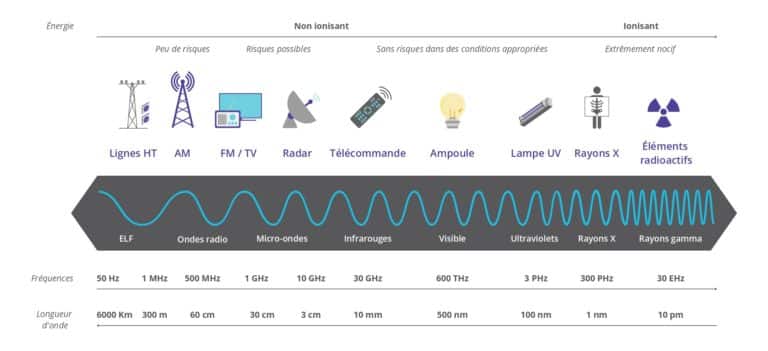What electromagnetic fields are we exposed to?
- 29/05/2023
- At home, At work, EMF & Health, Environmental health, In my city
In our daily lives, we are exposed to various types of electromagnetic field, ranging from radio waves to X-rays. These electromagnetic fields can be produced by a wide range of electronic devices, such as mobile phones, computers, radios, microwave ovens, television aerials, base stations, etc. But what electromagnetic fields are we really exposed to, and what are their potential effects on our health?

What is an electromagnetic wave?
An electromagnetic wave propagates through empty space or a material medium. It is made up of two mutually perpendicular components: an electric field and a magnetic field. These two fields vary in time and space.
They can have different frequencies, which determines their electromagnetic field length and energy. Low-frequency electromagnetic fields have longer wavelengths and lower energy. High-frequency electromagnetic fields have shorter wavelengths and higher energy.
It is important to note that excessive exposure to electromagnetic fields can have harmful effects on health, depending on the frequency and dose. Regulatory standards have been established to limit exposure to electromagnetic fields and minimise health risks.

Types of electromagnetic field
Radio electromagnetic fields
Radio waves are electromagnetic fields with a frequency between 3 kHz and 300 GHz. They are used for wireless communications such as radio, television, mobile phones and wireless networks.
Studies have shown that low-power electromagnetic fields do not cause direct damage to biological tissues (cells, organs, etc.). However, excessive exposure can have adverse effects on health, such as headaches, fatigue, dizziness and sleep disturbance. These effects are considered temporary and reversible.
Regulatory standards have been established to ensure that exposure levels remain below acceptable safety thresholds. Exposure limits vary according to the frequency and power of the electromagnetic field, and are generally more restrictive for children, pregnant women and people with certain medical conditions. In general, they are not considered hazardous to human health at current levels of exposure, as long as regulatory standards are respected.
Microwaves
Microwaves are electromagnetic fields with a frequency between 300 MHz and 300 GHz. They are used in a variety of applications, including wireless communications, microwave ovens, body scanners, television aerials and radar.
Exposure to microwaves can have health effects. The effects depend on the frequency, duration of exposure and power of the microwaves. At high levels, they can cause skin and tissue burns, as well as cataracts. Studies have also suggested that exposure to high levels of microwaves can cause neurological disorders and diseases such as cancer.
However, at normal levels of exposure, there is no conclusive evidence of health risks. Microwave exposure limits have been established by public health organisations, such as the World Health Organisation (WHO) and the International Commission on Non-Ionising Radiation Protection (ICNIRP), to ensure the safety of those exposed.
Using microwaves at levels above the recommended limits may be dangerous. We therefore recommend that you follow the safety instructions to avoid any potential health risk.
Infrared waves
Infrared waves are electromagnetic fields with a longer wavelength than visible light, but shorter than microwaves. They are produced by objects that emit heat, such as human bodies, animals and electronic devices.
Exposure to infrared electromagnetic fields has not been associated with adverse health effects at current levels of exposure. They are often used for pain therapy and stress reduction, as they can help relax muscles and improve blood circulation. Infrared saunas are also popular because they produce a dry heat that can help relax muscles and improve cardiovascular health.
However, prolonged exposure to high levels of infrared radiation can cause skin and tissue burns similar to those caused by prolonged exposure to the sun. It is therefore important to take precautions to avoid excessive exposure to sources of infrared radiation. Precautions include limiting exposure time, using sunscreen, wearing protective clothing and erecting protective barriers against sources of radiation.
X-rays
X-rays are a form of high-energy electromagnetic radiation with a shorter wavelength than visible light. They are used to produce internal images of the body, for medical diagnosis, as well as in other fields, such as industry and scientific research.
Exposure to X-rays can have harmful effects on health, particularly if exposure is repeated or prolonged. The acute effects of exposure to X-rays include reddening of the skin, nausea, vomiting and general fatigue. Long-term effects include genetic mutations, cardiovascular disease and cancer. Children and pregnant women are particularly vulnerable to the effects of X-rays.
To minimise health risks, it is important to limit exposure to X-rays to recommended levels and to use appropriate protective equipment, such as lead aprons and protective screens. Radiation doses must be as low as possible, while guaranteeing the quality of diagnostic images. Healthcare professionals and patients must be aware of the risks associated with exposure to X-rays and take all necessary precautions to minimise these risks.
Ionising radiation
Ionising radiation is electromagnetic radiation or particles that have enough energy to strip electrons from the atoms or molecules they pass through, creating charged ions. Common sources of ionising radiation include X-rays, gamma rays, alpha, beta and neutron particles.
Exposure to ionising radiation can have harmful effects on health. The effects can range from slight reddening of the skin to serious tissue damage and cancer. The acute effects of exposure to ionising radiation include nausea, vomiting, skin burns and cataracts. Long-term effects include genetic mutations, cardiovascular disease, thyroid disease and cancer.
Regulatory safety standards are established to limit levels of exposure to ionising radiation and minimise health risks. Radiation doses must be as low as possible, while guaranteeing the quality of the diagnostic images or the performance of the task. Healthcare professionals and workers exposed to ionising radiation must be trained to understand the risks and take all necessary precautions to minimise these risks, including the use of appropriate protective equipment.
Very low frequency electromagnetic fields
Very low frequency (VLF) electromagnetic fields are electromagnetic fields with frequencies below 300 Hz. They are generated by many sources, including high-voltage power lines, household appliances, heating and air-conditioning equipment and electronic devices. VLF electromagnetic fields have a very long wavelength, which means they can penetrate the human body and interact with cells.
The health effects of VLF electromagnetic fields are controversial and the subject of much research. Some scientists have suggested that electromagnetic fields could be linked to health problems such as cancer, heart disease, sleep disorders and fertility problems. However, there is still no scientific consensus on the extent of these effects and the underlying mechanisms.
The World Health Organisation (WHO) has classified ELF waves as “possibly carcinogenic to humans”, on the basis of studies suggesting an increased risk of leukaemia in children exposed to high levels of VLF waves. However, the WHO also notes that there are limitations to these studies and that the evidence is insufficient to establish a causal relationship.
It is therefore advisable to take precautionary measures to reduce exposure to very low frequency electromagnetic fields, such as moving away from emission sources, reducing exposure time and using protective equipment. People with known health problems or electromagnetic sensitivities may be more sensitive to the effects of VLF electromagnetic fields and should be particularly careful.
Conclusion
It is essential to understand the various sources of electromagnetic field to which we are exposed in our everyday environment. From electromagnetic fields, such as those emitted by mobile phones or base stations, to natural waves, our exposure is ubiquitous. However, it is important to stress that most of them are considered safe for human health, as long as we comply with the exposure limits recommended by regulatory authorities. So it’s vital to stay informed, take reasonable precautions and keep abreast of the latest scientific research to ensure our well-being in an increasingly connected world.


